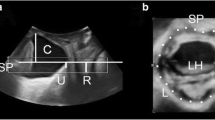Abstract
The purpose of this study was to evaluate pelvic organ support during pregnancy and following delivery. This was a prospective observational study. Pelvic organ prolapse quantification (POPQ) examinations were performed during each trimester of pregnancy and in the postpartum. Statistical comparisons of POPQ stage and of the nine measurements comprising the POPQ between the different time intervals were made using Wilcoxon’s signed rank and the paired t-test. Comparison of POPQ stage by mode of delivery was made using Fisher’s exact test. One hundred thirty-five nulliparous women underwent 281 pelvic organ support evaluations. During both the third trimester and postpartum, POPQ stage was significantly higher compared to the first trimester (p<0.001). In the postpartum, POPQ stage was significantly higher in women delivered vaginally compared to women delivered by cesarean (p=0.02). In nulliparous pregnant women, POPQ stage appears to increase during pregnancy and does not change significantly following delivery. In the postpartum, POPQ stage may be higher in women delivered vaginally compared to women delivered by cesarean.

Similar content being viewed by others
References
Mant J, Painter R, Martin V (1997) Epidemiology of genital prolapse: observations from the Oxford Family Planning Association Study. Br J Obstet Gynaecol 104:579–585
Samuelson EC, Victor FTA, Tibblin G, Svardsudd KF (1999) Signs of genital prolapse in a Swedish population of women 20 to 59 years of age and possible related factors. Am J Obstet Gynecol 180:299–305
Swift SE (2000) The distribution of pelvic organ support in a population of female subjects seen for routine gynecologic health care. Am J Obstet Gynecol 183:277–285
Peschers U, Schaer G, Anthuber C, Delancey JO, Schuessler B. Changes in vesical neck mobility following vaginal delivery. Obstet Gynecol 1996; 88:1001–6.
Meyer S, Schreyer A, DeGrandi P, Hohlfeld P (1998) The effects of birth on urinary continence mechanisms and other pelvic floor characteristics. Obstet Gynecol 92:613–618
Fynes M, Donnelly VS, O’Connell PR, O’Herlihy C (1998) Cesarean delivery and anal sphincter injury. Obstet Gynecol 92:496–500
Chaliha C, Kalia V, Stanton SL, Monga A, Sultan AH (1999) Antenatal prediction of postpartum urinary and fecal incontinence. Obstet Gynecol 94:689–694
Meyer S, Hohlfeld P, Achtari C, Russolo A, De Grandi P (2000) Birth trauma: short and long term effects of forceps delivery compared with spontaneous delivery on various pelvic floor parameters. Br J Obstet Gynaecol 107:1360–1365
Sze EHM, Sherad III GB, Dolezai JM (2002) Pregnancy, labor, delivery, and pelvic organ support. Obstet Gynecol 100:981–986
O’Boyle AL, Woodman PJ, O’Boyle JD, et al. (2002) Pelvic organ support in nulliparous pregnant and nonpregnant women: a case control study. Am J Obstet Gynecol 187:99–102
O’Boyle AL, O’Boyle JD, Ricks RE, Patience TH, Calhoun BC, Davis GD (2003) The natural history of pelvic organ support in pregnancy. Int Urogynecol J 14:46–49
Bump RC, Mattiasson A, Bø K, et al. (1996) The standardization of terminology of female pelvic organ prolapse and pelvic floor dysfunction. Am J Obstet Gynecol 175:10–17
Landon CR, Crofts CE, Smith AR, Trowbridge EA (1990) Mechanical properties of fascia during pregnancy: a possible factor in the development of stress incontinence of urine. Contemp Rev Obstet Gynaecol 2:40–46
Jackson SR, Avery NC, Tarlton JF, Eckford SD, Abrams P, Bailey AJ (1996) Changes in metabolism of collagen in genitourinary prolapse. Lancet 347:1658–1661
Swift SE, Pound T, Dias JK (2001) Case-control study of etiologic factors in the development of severe pelvic organ prolapse. Int Urogynecol J 12:187–192
Author information
Authors and Affiliations
Corresponding author
Additional information
The opinions and assertions contained herein are the private views of the authors and are not to be construed as official or reflecting the views of the Department of Defense. Reprints will not be available
Editorial Comment: The authors have performed a perspective observational study on pregnant women and performed POPQ examinations in each trimester and postpartum. The POPQ stage differed significantly between the first and third trimesters and between the first trimester and postpartum. No change was observed between the third trimester and postpartum. The mode of delivery was also recorded and there was no significant change in the POPQ examination of patients who delivered vaginally as compared to cesarean section. However, all the patients who underwent a cesarean section were in labor and the numbers are fairly low. The authors conclude that pregnancy itself is a risk factor in the development of pelvic floor disorders. This study is limited by its size and by the fact that an examination was not done in each trimester of the pregnancy in order to assess the progression of the pelvic floor disorder. It is however an interesting and useful study that may affect the debate on elective cesarean section for the prevention of pelvic floor disorders.
Rights and permissions
About this article
Cite this article
O’Boyle, A.L., O’Boyle, J.D., Calhoun, B. et al. Pelvic organ support in pregnancy and postpartum. Int Urogynecol J 16, 69–72 (2005). https://doi.org/10.1007/s00192-004-1210-4
Received:
Accepted:
Published:
Issue Date:
DOI: https://doi.org/10.1007/s00192-004-1210-4




